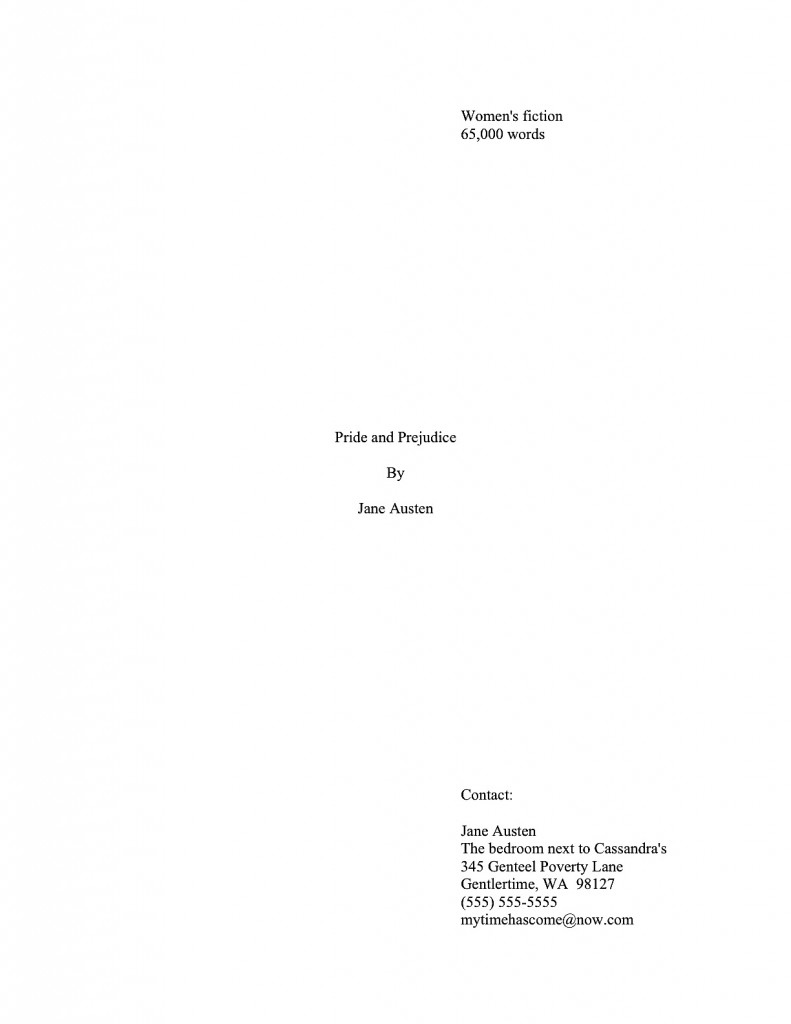





After last night’s rather depressing little post on how a relatively tiny tone adjustment can make the difference between a winning query letter and one that — how shall I put this? — does not tend to inspire confidence in Millicent the agency screener, it’s rather a relief to be winging our way back to presentation and packaging, isn’t it? This morning, I’m going to be picking up where we left off yesterday morning, talking about how a savvy writer should respond to a request for a partial manuscript.
A partial, for those of you new to the term, is a manuscript excerpt of a length specified by its requester — an agent, usually, although if an editor is considering buying the rights to one of her already-acquired authors’ next book before it is finished (and thus preventing it from being subject to bidding from other publishers), she may ask for a particular number of pages or chapters.
How writers who have not yet landed agents typically encounter a partial is after a successful query or pitch. Rather than requesting the entire manuscript, the agent (or, more commonly for queries, the agent’s Millicent) will say something like, “Send us the first 50.” Then, if they like what they see in those opening pages, they will request either a longer piece (as in, “Send us the first 100.”) or the full manuscript.
The lengths of partials vary by agency — 50 pages, the first three chapters, and 100 pages traditionally being the most popular options — but a partial will always begin on page 1. Which means, in practice, that if you’re first told to send the first three chapters and later asked for the first 100, the first submission packet might contain pp. 1-62, but the second would invariably contain pp. 1-100.
Why? Well, weeks or months might pass between the time Millicent finished reading the first submission and sat down to enjoy the second. You wouldn’t expect her just to pick up where she left off last time, would you? She reads far, far too many manuscripts to remember the details of even one she liked two months ago.
But I’m getting ahead of myself, amn’t I? Before I delve into the rather intense implications of that last paragraph, let’s make sure we’re all on the same page, so to speak. How do the requested pages of a partial differ from the pages an agency’s website might say queriers should include with their letters?
Glad you asked. You will be, too, I suspect.
REQUESTED MATERIALS — and well, everything else
To be absolutely clear, I’m not talking about sending pages to an agency whose guidelines specify that queriers should include the first chapter, a few pages, or a synopsis with a query — all of these would, in the industry’s eyes, be unsolicited materials. Partials are always requested materials, meaning that a specific agent asks an individual writer to send (usually by regular mail) a predetermined number of pages.
Yes, yes, I know: it’s a bit counter-intuitive that a blanket statement in an agency’s submission guidelines that any agent currently operating under its roof would like to see certain materials from every querier doesn’t constitute solicitation, but according to the logic of the industry, it doesn’t. A list of what should go in a query packet does not a personal solicitation of even those same materials make.
Why am I raining on the partials parade by mentioning this up front, you ask? Because the consequences of confusing solicited and unsolicited manuscripts tend to be very, very high for the writer who blithely mails off the latter. So let’s run over the difference in a touch more detail, shall we?
A solicited submission consists of manuscript pages that an agent is waiting to see, usually following a successful pitch or query. An unsolicited submission consists of a stack of manuscript pages from a writer who has not yet been personally asked to send anything.
Ne’er the twain shall meet, my friends. If an agency or small publishing house’s submission guidelines do not SPECIFICALLY state that it wants to see pages, sending unsolicited materials almost universally results in those pages being rejected immediately, unread.
Continuing that logic, when an agency’s guidelines say something like include the first chapter, that should not be read as an assurance that every first chapter sent to it will be read — which is, let’s face it, precisely what the vast majority of queriers believe such guidelines to be promising. But reading the entire contents of every single query packet would be highly unusual, and not very efficient: as we have been discussing for much of the summer and shall be again later this week, most submissions contain rejection triggers on page 1. Sad, but true.
Only if Millicent finds the query letter compelling will she read any of the attached materials at all, which has even more drawbacks for the querier than might at first be apparent. Think about it: why would an agency want to see an unsolicited writing sample — which is, effectively, what any pages in a query packet constitute — with a query?
To save overall processing time, of course: in the long run, it’s significantly less time-consuming for Millicent to be able to check those opening pages for rejection triggers while the query is still in her hand. How so? Well, the alternative — responding to the query with a request for a partial, waiting until it arrives, waiting until the submission packet works its way to the top of the reading pile, then scanning the opening pages for rejection triggers — eats up both the agency’s time and space, yet 98% of the time, yields precisely the same result.
Thus, from the rejected writer’s point of view, the primary difference between mailing a query packet containing that unsolicited first chapter and sending off just the query, waiting for a response, receiving a request for a partial, dispatching it, and hearing back in the negative is speed. While rapid turn-around is really only a plus if the answer is yes — and even then, the best possible outcome from a query packet is a request for the full manuscript, not an offer of representation.
Oh, hadn’t I mentioned that an agent’s accepting a client on a partial alone is practically unheard-of? That agency whose guidelines thrilled you by saying you could send 50 pages with your query will want to see the rest of your book before making up its mind about your writing, after all.
Do I spot some tears trembling in eyes reading this? “But Anne,” those who have been favoring agencies that allow page submission with queries point out, and who could blame them? “I thought — well, never mind what I thought. But there’s still a benefit to the querier in sending those unsolicited materials if the agency says it’s okay, right? I mean, if Millie likes my query, she can fall in love with my writing on the spot. So from my perspective, this kind of query letter is quite a bit less time-consuming, too: it gets me to the full manuscript request stage that much quicker.”
Potentially — but the accepted querier’s gain in speed is bought at the cost of the rejected querier’s not knowing whether her packet got rejected due to something in the query letter or in the enclosed manuscript pages. Even if Millicent did scan the attached pages before rejecting the packet, the writer will almost certainly never find that out. Few US agencies give specific rejection reasons anymore (yes, that missive expressing regret that I just didn’t love this enough to feel confident trying to place it in the current competitive market was a form letter), so the more materials in the query packet, the more the rejected querier is left to speculate on what needs to be revised.
I’m not bringing all of this up to depress you (although I recognize that may be the effect) or to discourage anyone from querying any agency that asks for writing samples up front. It’s just important to recognize that those pages are in fact writing samples — and thus unsolicited submissions, not requested materials.
Expect them to be treated accordingly. Believe me, the querying and submission process will be easier on you that way.
Everyone clear on the distinction between requested and unsolicited pages? Okay, here’s a pop quiz, just to be sure: why is a partial invariably a solicited submission? (For bonus points, work into your answer the magic words a savvy submitter always writes on the outside of an envelope or places in the subject line of an e-mail bearing the partial to an agent.)
If you immediately leapt to your feet and shouted, “By jingo, a partial is a solicited submission by definition, because a partial is the precise number of pages the agent in question asked to see,” pat yourself on the back three times. If you took a deep breath and added, “And I would never dream of sending any manuscript, partial or otherwise, that an agent or editor had asked to see without whipping out my trusty black marker and writing REQUESTED MATERIALS in 2-inch-high letters on the front of the envelope and/or in the subject line of the e-mail,” award yourself another couple of hearty congratulatory slaps.
Then fling yourself onto the nearest chaise longue and take a few nice, deep breaths. That lulu of a second answer must have used up every cubic millimeter of oxygen in your lungs.
Now that you’ve caught your breath, shall we remind the rest of the class about why a savvy writer always scrawls REQUESTED MATERIALS on a submission? The answer to this one’s as easy as pie: so the requested materials can’t possibly be mistaken for an unsolicited submission.
That, and so those pages the agent asked to see will end up on the right end of Millicent’s desk — or, at a large agency, on the right Millicent’s desk, period. As painful as it may be for aspiring writers to contemplate, submissions can and sometimes do get misplaced; good labeling renders that dreadful eventuality less likely.
(It’s less painful for agented writers to contemplate, typically; most of us have already lived through the trauma of having a manuscript go astray. A certain agency that shall remain nameless as long as I remain signed with them not only lost one of my manuscripts back in my submitting days; it sent me another writer’s rejected manuscript in my SASE. They were quite apologetic when I returned it to them, along with a note suggesting that the author might be a better recipient for it.)
Oh, did the implication that submitting electronically might require some different steps catch you off-guard? Let’s rectify that with all deliberate speed.
Submitting your partial via e-mail
Caution: all of what I’m about to say in this section refers to electronic submission of requested materials, not unsolicited ones. For guidance on sending a query packet by e-mail, check each individual agency’s website for specific guidelines. (Had I already mentioned that every agency has its own set of expectations and preferences?)
When submitting requested materials via e-mail — a route a savvy writer takes only when an agent specifically requests it; even at this late date, many agencies do not accept electronic submissions at all, even if they accept e-mailed queries — include your partial as a Word attachment. (As much as some writers may prefer other word processing programs, Word is the industry standard. For another workable alternative, please see helpful reader Jens’ recent comment on the subject.) If you work on a Mac, make sure to check the Send Windows-friendly attachments box; most agencies operate on PCs, and not particularly new ones at that.
You want the agent of your dreams to be able to open your document, don’t you? Millicent tends to be very, very cranky when she can’t open an attachment, and even at this late date, few NYC-based agencies employ an in-house computer expert. So the sooner any writer gets used to the idea that any computer compatibility problems are likely to be considered the writer’s problem, not the agent’s, the happier your working life will be.
Speaking of difficulties opening files — or, as Millicent likes to call them, “what happens when writers don’t know what they’re doing” — it’s also an excellent idea for those working on the newest generation of Word to send the document in an older version. Specifically, send it as .doc file (Word 97-2004), not as a .docx file (anything more recent). The Save As… option under the FILE menu will allow you to make this switch easily.
Yes, I know it’s 2010. Try explaining that to a Millicent who’s stuck working on a decade-old PC that’s running a 2003 operating system — and trying to upload a submission onto her boss’ 2009 Kindle. Make her life easier.
If you are submitting requested materials via e-mail, use the body of the e-mail for your cover letter, but include any additional requested materials as separate attachments. In other words, unless the agent actually asked you to combine elements or place the whole shebang into the body of an e-mail (rare, but it happens; agents are as reluctant to download viruses as anybody else), the author bio should not be in the same document as the partial, and Millicent should be able to open your synopsis without having to scroll through the first 50 pages of your manuscript.
The sole exception: include your title page in the partial’s file, not as a separate document. Or, to put it another way, the title page should be the first page in the partial document, followed by the first page of text. Remember, though, that the title page should neither be numbered nor carry a slug line:

Unlike the first page of text — or any other page of text, for that matter:

Is that wheezing sound an indicator that those of you who meticulously constructed your title pages as separate documents have begun to hyperventilate? Not to worry — adding your title page to your partial file is as easy as copying it, pasting it into the beginning of the partial, and adding a page break. No fuss, no muss, and very little bother.
And yet the wheezing continues. “But Anne,” a few of you gasp, “if I send the title and the body of the partial in the same Word document, won’t the title page automatically have a slug line — and be numbered, too?”
Not necessarily — but there is a trick to it. Under the FORMAT menu, select Document, then Layout. Here, select the Different First Page option, then click OK. That, as the option’s name implies, will give your first page a different header and footer than the rest of the partial. After that, it’s simply a matter of placing the slug line in the header for the first page of text.
Before you have to waste breath asking, allow me to add: in order to prevent Word from counting the title page as page 1 and the first page of text as page 2, use the Format Page Number option under VIEW/Header and Footer to set the Start at… number to zero. Voilà! The first page of text is now page 1!
Hey, what did you mean, any additional requested materials?
Just as some agencies’ guidelines call for pages to be included in a query packet and some do not, some partial-requesting agents ask writers to slip additional materials into a submission packet. Obviously (and I do hope that it is indeed obvious to you by this point in our discussion), you should not include any extra materials unless the agent asks for them — but it never hurts to have any or all of the following on hand at querying time, just in case somebody requests one or more of them.
To continue the lengthy tradition that I started a couple of days ago — ah, those were happy times, were they not? — let’s run through the most popular additions in the order they should appear in a hard-copy submission packet:
1. Cover letter
2. Title page
3. The requested pages in standard format.
4. Synopsis, if one was requested, clearly labeled AS a synopsis.
Here again, terminology may not be the writer’s friend. With fiction or memoir, when an outline is requested, they usually mean a synopsis, not an annotated table of contents of the kind one might find in a book proposal. For nonfiction, however, an outline pretty much always means an annotated table of contents.
Most of the time, though, what an agent will ask to see for any types of book is a synopsis: a 1-5 page (double-spaced) overview of the basic plot or argument of the book.
If you don’t already have one handy, or if you’re not happy with the one you have, make sure to turn back in on Thursday, September 23rd for the gala opening of Synopsispalooza! (Hey, you asked; I listened.)
5. Marketing plan, if one was requested.
These were all the rage a few years ago for both fiction and memoir, but since the economy slowed down, they seem to have fallen out of favor as a submission-packet request, especially for partials. But just in case you get asked to produce one, a marketing plan is a brief (2-5 pages, double-spaced) explanation of who the target audience is for a particular book, why this book will appeal to those readers, and what you — not the publishing house’s marketing department, but YOU, the author — will do in order to alert potential readers to that appeal.
Sound familiar? It should –it’s an expanded version of the target audience and platform paragraph of the query. There are also entire sections of the book proposal devoted to these very subjects. That’s where fiction agents got the idea.
If a first-time novelist happens to have a terrific platform for the book she’s writing — if she’s the world’s leading authority on drive-in movie theatres, for instance, and her novel happens to be set in one — an agent may well wish to tuck a marketing plan that talks about all the lectures on drive-ins (and in drive-ins) the author is going to be giving over the next couple of years.
As I said, though, it’s largely fallen out of fashion for fiction. But let me turn it around to you: have any of you novelists been asked to provide marketing plans with your submissions lately? If so, let me know, and I’ll run a brief series on how a novelist might go about pulling one together.
6. Author bio, if one was requested.
An author bio is a one-page (double-spaced) or half-page (single-spaced) plus photo account of the submitting writer’s professional credentials. Typically, when an agent submits a manuscript or book proposal to editors, the author bio is the last page in the stack of paper.
Since author bios are far from easy to write, I always recommend that aspiring writers construct them well in advance, so they have a great one on hand to tuck into the submission packet. I suspect that I’m going to yield to those nagging voices in the ether and launch Authorbiopalooza immediately after I put Synopsispalooza to bed. Stay tuned.
7. A SASE big enough that everything you’re sending the agent can be returned to you
Out comes the broken record again: always use stamps, not metered postage, for the SASE.
“But Anne,” my formerly-wheezing readers point out, and rightly so, “isn’t the whole point of this mini-series to address the specific challenges of the aspiring writer who hasn’t been asked to send the entire manuscript? Correct me if I’m wrong, but wouldn’t the first three chapters of most manuscripts fit into a 10″ x 17″ Manila envelope?”
You are far from wrong, ex-wheezers: a nice, crisp Manila envelope is just the thing for submitting a partial. Fold a second envelope in half and poke it into the first as the SASE.
8. Optional extras.
These days, even if a writer submits requested materials via regular mail, she will probably receive a positive response via e-mail. (That will probably be a form letter, too, but you’ll mind it less.) However, if you want to send a second, business-size envelope SASE as well, to make it easy for Millicent to request the rest of the manuscript, place it at the bottom of the packet (and mention it in your cover letter.)
Since the vast majority of agencies are congenitally allergic to submitters calling, e-mailing, or even writing to find out if a manuscript actually arrived — check the agency’s website or guide listing to be sure — it’s also a fair-to-middling idea to include a self-addressed, stamped postcard for the agency to mail to you to acknowledge receipt of the manuscript. As I mentioned the other day, to generate a chuckle in a hard-worked Millicent, I always liked to send a SASP that looked like this — although with a stamp attached, of course:
Don’t worry about this causing trouble; it doesn’t, provided you do it courteously, and you will have proof that they received it. This is important, because as I MAY have mentioned, manuscripts do go astray from time to time.
Want to get the same information without running the risk that a witty postcard won’t elicit a chuckle? Pay a little more at the post office for the Delivery Confirmation service; they’ll give you a tracking number, so you may follow your submission’s progress through the mail.
What you should most emphatically not do is send your submission via a mailing service that will require someone at the agency end to sign for the packet. Although this would obviously be the best proof, should you ever need it, that the manuscript did in fact arrive, signature-requiring packages fall under the rubric of Millicent’s most notorious pet peeves — why, she reasons, should she (or the guy in the mail room) have to take time out of her (or his) busy day just because some writer is nervous?
9. Pack it all in your Manila envelope and write REQUESTED MATERIALS on the front.
Straightening up the stack of paper will minimize the possibility of in-transit mutilation, incidentally. If the envelope you have selected is a tight fit — snug enough, say, that the pages might get wrinkled in the stuffing-in process — for heaven’s sake, find yourself a larger envelope. As we’ve discussed, it’s in your interest for it to arrive pretty.
Oh, and while I have your attention, this seems like a dandy time to haul out the broken record player again. (You’d thought you’d seen the last of it, hadn’t you?)
No matter how many pages or extra materials you were asked to send, do remember to read your submission packet IN ITS ENTIRETY, IN HARD COPY, and OUT LOUD before you seal that envelope. Lest we forget, everything you send to an agency is a writing sample: impeccable grammar, punctuation, and printing, please.
Tomorrow morning, we’ll be wrapping up this discussion of partials via a quick tour of the major mistakes aspiring writers tend to make in constructing their submission packets. Meanwhile, adhering to our recent packaging/content post alternation plan, tonight’s 8 pm PST post will be devoted to another round of examples of good and less-good queries.
Until then, slice that pie and pack it for traveling nicely; the extra time to package it professionally honestly is worthwhile. Keep up the good work!

Love the query help. If you are still taking votes I’d like see Howtofindanagentinmygenrepaloza!
I’m so glad to hear it, Trey — and yes, I’m still taking votes. Duly noted.
Yay Synopsispalooza!
I have a 1-page, 2-page, 5-page and 8-page. I want to make them pop, however.
Poor Anne; your fingers are going to fall off!
I’m kind of looking forward to Synopsispalooza, Elizabeth. Although I must confess, my hands are even more enthusiastic about ending this posting-more-than-once-per-day business.